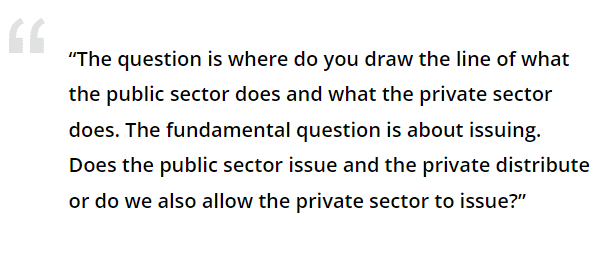IMF Official Says Public-Private CBDC Offers Best of Both Worlds
Tommaso Mancini-Griffoli, a representative from the International Monetary Fund, believes that a synthetic private-public partnership could be the best way forward for a central bank digital currency.
Mancini-Griffoli, the IMF’s Monetary capital markets department deputy division chief, joined the Money Movement’s latest live session on May 26. The show, which is hosted by Circle CEO Jeremy Allair, explores various themes relating to economics and technology.
Mancini-Griffo said that the idea of creating a CBDC solely backed by a central bank's reserve and completely under the control of a central bank, is outdated.
A synthetic private-public partnership CBDC, on the other hand, is gaining popularity among the digital currency world and will empower private sectors such as blockchain backed stablecoins to continue to innovate.
He suggested the private sector concentrates on innovation, interface design, and client management. The public sector remains focused on regulation and underpinning trust. This will encourage innovation to continue but within a regulated framework for financial stability.
Regulation plays a key role
According to Mancini-Griffoa, unlike the original idea of CBDC which requires the central banks issuing a liability directly to the public, a synthetic CBDC allows the private sector to issue a liability that is used by people to purchase assets for payments.
The liability would be fully backed by the central bank’s reserves. Central banks would also issue licenses for the liability, which would help to regulate and supervise businesses and institutions.
A regulated environment may provide an equal playing field for all the private sector stablecoin innovators to continue to grow. He believes that it could also mitigate against the potential financial stability risks that they pose. He explained that:
Migrating risks and encourage innovation
The public-private partnership CBDC would also encourage competition between digital currency providers and preserve comparative advantages, says Mancini-Griffoa.
Much of the cost and risk for the public sector, such as technology choices, customer management, customer screening and monitoring including for Know Your Customer, Anti-Money Laundering, and regulatory compliance. Data management would be transferred to the private sector.
Public and private partnership challenges
The synthetic CBDC is gaining traction, yet challenges still remain. Mancini-Griffoa pointed out that the best way to design a private and public partnership is an ongoing debate, as is deciding who should have the ability to issue the aforementioned tokens. He added that:
Stablecoin and banks collaboration looks promising
Mancini-Griffoa emphasizes that the intention is not to “rock the boat” of the banking world. He states:
However, innovative banks will adopt a lot of the new technologies, such as blockchain-backed stablecoins. These stablecoins are irreversible, secure, fast, and capable of processing transactions with a global reach for settling final payments. There will probably even be partnerships between bank and payment services, according to Mancini-Griffoa.
As Cointelegraph reported previously, the Bank of China appears to believe that the digital yuan will be able to eventually replace cash. Stablecoin experts have pointed out that privacy, custodianship, and financial stability would be the three most challenging elements a CBDC would face.


